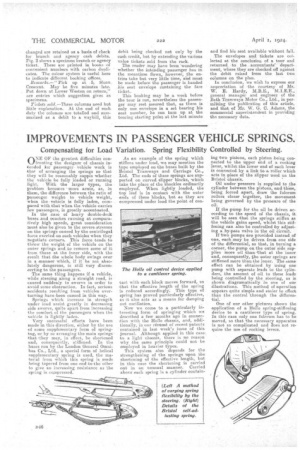IMPROVEMENTS IN PASSENGER VEHICLE SPRINGS.
Page 40

If you've noticed an error in this article please click here to report it so we can fix it.
Compensating for Load Variation. Spring Flexibility Controlled by Steering.
ONE OF the greatest difficulties con-Freon-ling the designer of chassis intended laic passengervehicle work is that of arranging the springs so that they will be reasonably supple whether the vehicle be fully loaded or running light. With the larger types, the problem becomes • more acute, as, in them, the difference between the ratio of passenger weight to vehicle weight, when the vehicle is fully laden, compared with that when the.vehicle carries few passengers, is greatly -accentuated.
In the case of heavy double-deck buses and coaches running at comparatively high speeds, great consideration must also be given to the severe -stresses on the springs caused by the centrifugal force exerted on such vehicles when they negotiate corners. This force tends to throw the weight of the vehicle on the enter springs and to remove some of it from those at the inner side, with the result that the whole body .swings over in a manner which, if it be not absolutely dangerous, is still very disconcerting to the passengers.
The same thing happens if a vehicle, while steering along a straight road, is caused suddenly to swerve in order to avoid some obstruction. In fact, serious accidents resulting from vehicles overturning have 'been caused in this way.
Springs which increase in strength wider load assist greatly in decreasing side swerve, quite apart from increasing the comfort, of the passengers when the vehicle is lightly laden.
Very successful efforts have been made -in this direction, either by the use of some supplementary form of springing, or.by so arranging the main springs that 'they may, in effect, be shortened and, consequently, stiffened, In the buses run by the London General Omni
bus Co., Ltd., a special form of helical supplementary spring is used, the ma terial from which this spring is made being tapered from one end to the other to give an increasing resistance as the spring is compressed.
As an example of the spring 'which stiffens under lead, we may mention the type employed on the buses built by the Bristol Tramways and Carriage Co., Ltd. The ends of these springs are supported on curved slipper blocks, 'which take the place of the &hackles ordinarily employed. When lightly loaded, the top leaf is in contact with the outer ends of these blocks, bnt as they are compressed under load the point of con
tact with each block moves forward, so !that the effective length of the spring is reduced accordingly. This type of spring has proved particularly effective, as it else acts as a means for damping out oscillation.
Now we come to a particularly interesting form of springing which we described a few months ago in connection with the Hale chassis, and, additionally, in our resume of recent patents contained in last week's issue of this journal. Althouge applied in this case, to a light chassis, there is no reason why the same principle could not be employed in heavier types. This system also depends for the strengthening of the springs -upon the shortening of the effective length, but in this case the shortening is carried out in an unusual manner. Carried above each spring is a cylinder contain kg_ two pistons, each piston being connected to the upper end of a rocking lever, whilst the lower end et each lever is connected by a link to a roller which acts in place of the slipper used on the Bristol chassis.
Oil under pressure is supplied to ,the cylinder between the pistons, and these, 'being, forced apart, draw the fulcrum rollers closer together, the movement being governed by the pressure of the ail.
If the pump for the ail be driven according to. the speed of the chassis, it will he seen that the springs stiffen as the vehicle gains speed, whilst this stiffening can .also be controlled by adjusting a by-pass valve in the oil circuit.
If two pumps are provided instead of one, each may be driven from one side of the differential, so that, in turning a corner, the pump on the outer side supplies more ail 'than-that at the inner -and, consequently, the outer springs are stiffened more than the inner. The same effect can be obtained by Using one pump with separate leads to the cylinders, the amount of oil to these leads being controlled by the steering, as is shown diagraniatic.ally in one of mar illustrations. This method of operation appears quite simple and easier to effect than the .control through the differential.
One of our other pictures shows the application of a Halle spring-stiffening device to a cantilever type of spring. In this ease only one fulcrum has to be moved, so that the necessary apparatus is not so complicated and does not require the use of rocking levers.






















































